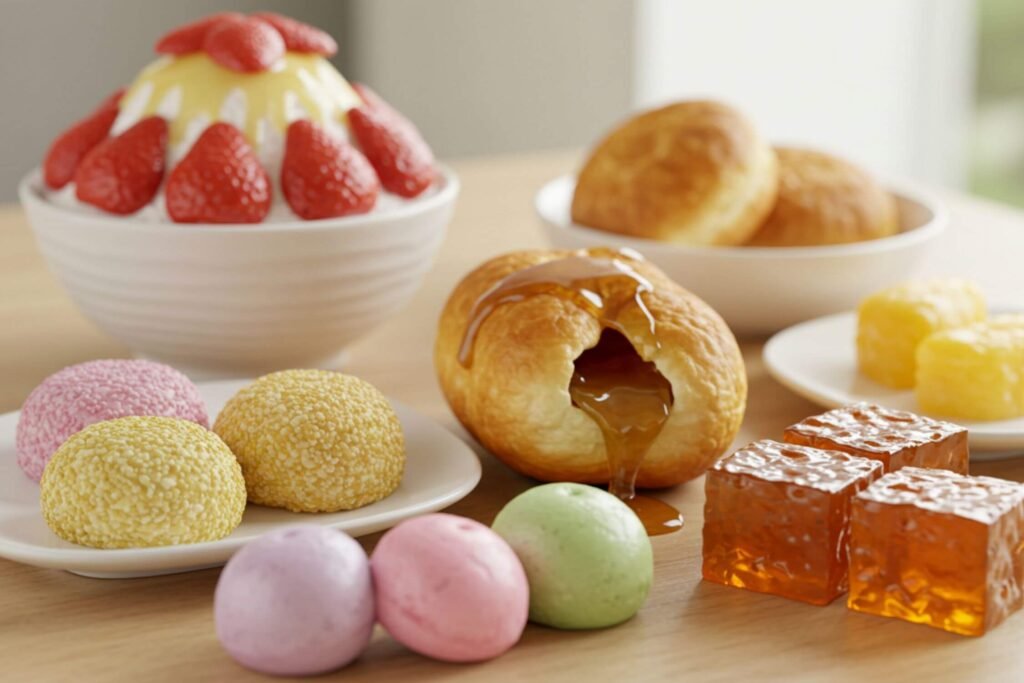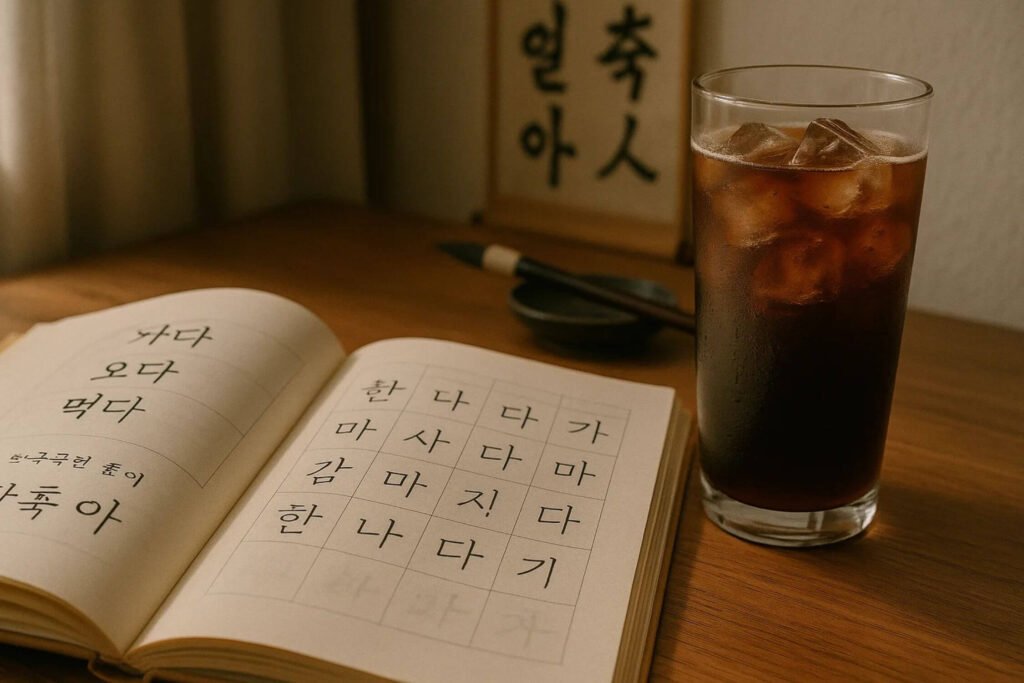Korean cuisine is world-famous for its spicy dishes and flavorful street food, but its dessert scene is just as rich, unique, and mouthwatering. From traditional rice cakes to modern café creations, Korean desserts offer a mix of textures, colors, and flavors that can delight any sweet tooth. Whether you’re exploring Korea in person or looking for new treats to try at home, discovering the best Korean desserts is like diving into a sweet world of culture and creativity.
In this article, we’ll take you on a journey through ten of the best Korean desserts you simply have to try. Each one offers a different experience—from chewy to crunchy, from icy to creamy—showcasing the diversity and innovation in Korean sweets.
1. Bingsu (빙수)
If there’s one dessert that defines Korean summers, it’s bingsu. This shaved ice treat is nothing like the average snow cone. Made with ultra-fine ice shavings, often using milk instead of water, bingsu is topped with a wide array of ingredients such as sweetened red beans, condensed milk, chopped fruit, mochi pieces, nuts, and even cheesecake or brownies in modern versions. Patbingsu, the traditional variety, features red bean paste as the primary topping, offering a nostalgic, earthy sweetness.
Cafés across South Korea now compete to make the most Instagram-worthy bingsu creations, with towering bowls that are as beautiful as they are refreshing. Whether you’re a fruit lover or a chocolate addict, there’s a bingsu out there with your name on it.
2. Hotteok (호떡)
When the weather turns chilly, nothing beats the comforting warmth of hotteok. These sweet Korean pancakes are a beloved winter street food, typically filled with brown sugar, cinnamon, and chopped nuts. As they cook on a griddle, the sugar filling melts into a gooey, caramel-like center that oozes out with every bite.
Hotteok has evolved with the times, and now you can find variations filled with green tea paste, cheese, or even pizza ingredients. But it’s the classic version—with its crisp outside and molten inside—that remains a must-try for anyone seeking authentic Korean flavor in dessert form.
3. Tteok (떡)
Tteok, or Korean rice cake, is a staple in Korean traditional cuisine and often makes appearances during holidays, birthdays, and weddings. It’s not one single dessert but a category of many varieties made primarily from glutinous rice flour. Some are sweet, others savory, and many are used in ceremonial offerings.
One of the most popular sweet versions is injeolmi, a chewy rice cake coated in roasted soybean powder, giving it a nutty, subtly sweet flavor. Another well-known type is songpyeon, crescent-shaped tteok filled with sesame seeds, red bean paste, or chestnuts, usually served during Chuseok (Korean Thanksgiving).
While the texture might be new to some, tteok offers a deeply satisfying chewiness and a connection to centuries of tradition.
4. Korean macarons (뚱카롱, ddongcaron)
At first glance, Korean macarons might remind you of the delicate French version—but they’re a different beast altogether. Known as ddungcaron or “fatcarons,” these are supersized macarons stuffed with thick layers of flavored cream, cookies, fruit jams, and candy pieces.
Korean macarons are more than just a dessert—they’re a trend. They’ve taken over cafés and Instagram feeds thanks to their creative flavors and over-the-top appearances. Popular fillings include matcha, chocolate ganache, Oreo, strawberry cream, and even traditional Korean ingredients like black sesame or injeolmi powder.
If you’re after a rich, indulgent treat that’s both stylish and satisfying, Korean macarons are hard to beat.
5. Yakgwa (약과)
For a taste of Korea’s past, look no further than yakgwa. This traditional honey cookie has been enjoyed since the Goryeo Dynasty. Made from wheat flour, sesame oil, ginger juice, and honey or rice syrup, yakgwa is deep-fried and then soaked in a sweet, spiced syrup, giving it a soft, chewy texture with hints of ginger and sesame.
Its floral, geometric design and glossy glaze make it not only tasty but also visually striking. Yakgwa is often served with tea and is a common gift during Korean holidays. If you appreciate desserts with historical roots and complex flavors, yakgwa is a must-try.
6. Hwachae (화채)
During Korea’s humid summers, hwachae is a refreshing way to cool down. This traditional Korean fruit punch is made with a base of sweetened water or honeyed juice, combined with floating fruits such as watermelon, strawberries, and pears. One of the most iconic versions, subak hwachae, features watermelon balls served in their own hollowed-out rind, often with a hint of milk or soda for extra fizz.
Hwachae isn’t just a thirst-quencher—it’s a celebration of seasonal fruit and vibrant color. You’ll often see it at summer gatherings or parties, offering a light, hydrating alternative to heavy desserts.
7. Korean ice cream (아이스크림)
When it comes to ice cream, South Korea takes it to the next level. Korean convenience stores and dessert cafés offer a dazzling range of unique ice cream options that go way beyond vanilla and chocolate. From fish-shaped bungeoppang ice cream filled with red bean paste and soft serve, to chewy melona bars in flavors like banana and honeydew, there’s no shortage of creativity.
One standout is J-cone ice cream, a tall swirl of soft serve inside a crunchy, J-shaped puffed corn cone. Then there’s Samanco, the fish-shaped ice cream sandwich layered with red bean and vanilla. If you’re looking for fun, unexpected twists on classic ice cream, Korea is full of frozen surprises.
8. Dalgona candy (달고나)
Dalgona isn’t just a viral coffee trend—it’s also a beloved childhood treat in Korea. This honeycomb toffee candy is made by melting sugar and stirring in a bit of baking soda, which causes it to puff up into a light, airy texture. The mixture is poured onto a flat surface and often stamped with shapes like stars or hearts.
In the past, children would buy dalgona from street vendors and try to carve out the shape using a needle without breaking the design—a sweet game with a tasty prize. Thanks to global attention from shows like Squid Game, dalgona candy has made a comeback, both in Korea and abroad.
9. Misugaru latte (미수가루 라떼)
Though technically a drink, misugaru latte deserves a spot on any dessert list. This creamy, slightly sweet beverage is made from a multigrain powder blend including barley, black rice, millet, and soybeans. Traditionally consumed for its health benefits, misugaru has gained popularity as a trendy, nutritious dessert drink.
When mixed with cold milk and a bit of honey or sugar, it becomes a deliciously nutty and refreshing treat, perfect for warm afternoons. Cafés across Korea now offer this drink alongside cakes and pastries, giving health-conscious dessert lovers an option that satisfies both taste and nutrition.
10. Korean roll cake (롤케이크)
Korean roll cakes take inspiration from the classic Swiss roll but offer lighter textures and more creative fillings. These soft sponge cakes are rolled with whipped cream and flavored layers like matcha, strawberry, yuzu, or chocolate. What sets Korean roll cakes apart is their elegant design and delicate balance of sweetness—never too rich, yet still satisfying.
Some bakeries even incorporate local ingredients like red bean, injeolmi powder, or sweet potato, giving traditional Korean flavors a modern, cake-based twist. They’re the perfect pairing with tea or coffee and make for a light yet indulgent way to end any meal.
Bottom line
From icy bingsu to chewy rice cakes, Korean desserts are as varied and vibrant as the culture itself. Whether you prefer rich and indulgent treats or light and refreshing snacks, there’s a Korean dessert to satisfy every craving. The best part? Many of these sweets are deeply tied to Korean history and traditions, offering not just a taste of sugar, but a taste of the country’s soul.
If you’re traveling in Korea, make it a mission to sample as many of these as you can. And if you’re at home, look out for Korean bakeries, cafés, or Asian supermarkets that offer these gems. Better yet, try making some of them yourself—the internet is full of recipes that bring the flavors of Korea right into your kitchen.



